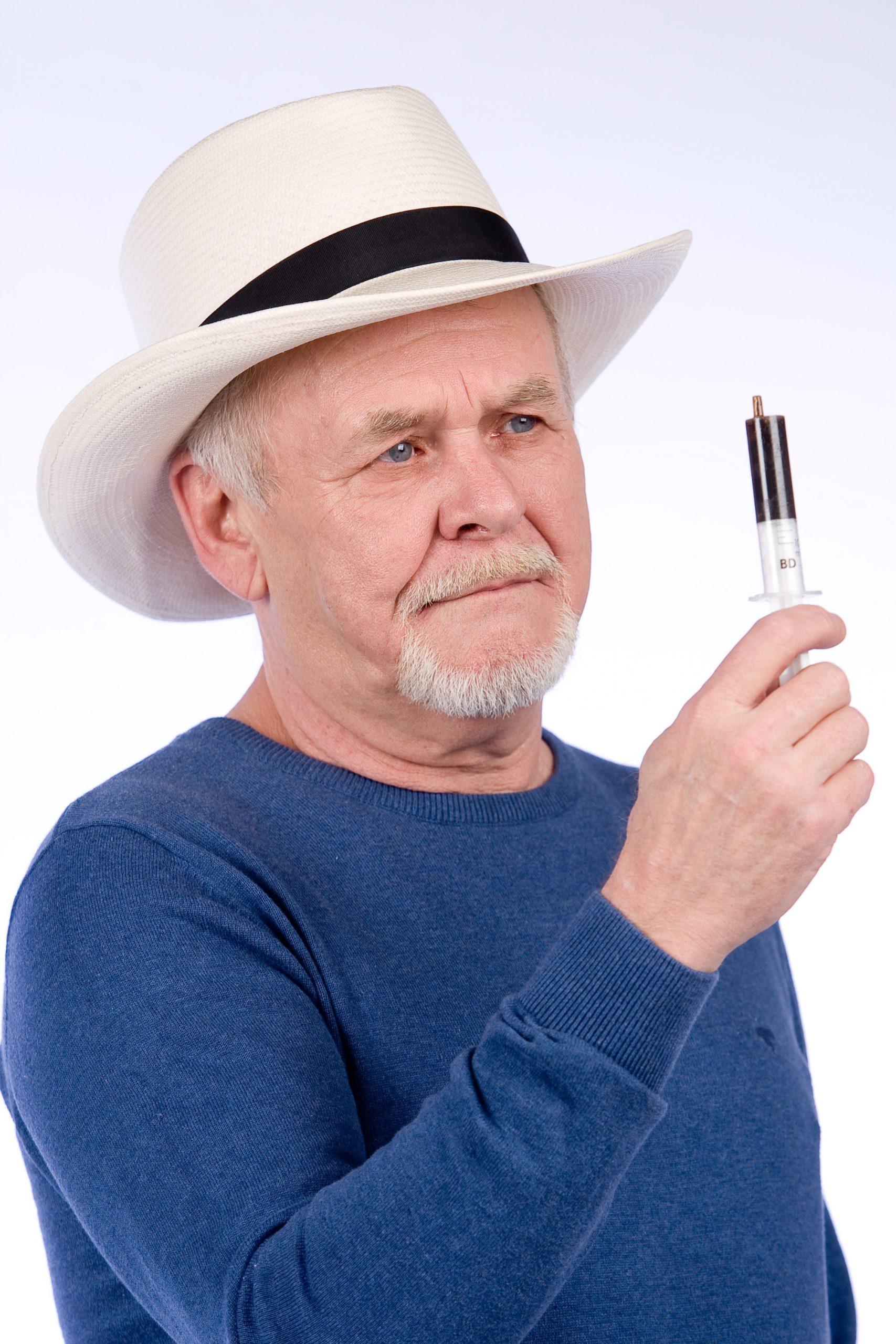
Rick Simpson (pictured above) has helped revolutionize and popularize the use of cannabis oil. Photo by Davor Pongracic
Countless men and women have fought vigorously for society to accept, legalize and provide access to cannabis. While there are many advocates who helped catalyze the cannabis movement, we are putting a spotlight on a few of these unsung heroes.
Spurring Studies and Sharing Knowledge
Dr. Raphael Mechoulam is the organic chemist whose team was the first to isolate and identify many of the plant’s chemical compounds, including THC, reports The Journal of Cannabis Research.
Such discoveries helped spur research, and broadened understanding of cannabinoids. As a result of this work, Mechoulam—who passed away in 2023—earned the title as “the godfather of cannabis research.”
While he is credited with initially identifying several cannabinoids, Dr. Allyn Howlett, a biochemical neuropharmacologist, discovered the CB1 receptor. This receptor plays an integral role in the body’s response to cannabinoids. It is stimulated or antagonized by cannabinoids like CBD, and is involved in processes including appetite, memory, mood, pain and more.
Howlett’s discovery “opened the floodgates of research into the endocannabinoid system with huge implications for nearly every area of medical science,” reports Project CBD.
Jorge Cervantes, American horticulturist and writer, has also dedicated his life to medical cannabis. He grew cannabis professionally in California and in Oregon before he eventually realized that there was a huge gap in knowledge about growing indoors, in greenhouses, and outdoors. This prompted him to investigate the cultivation process. He then created questionnaires and interviewed cannabis growers.
“I worked as a survey researcher for a few months and learned a lot about asking questions to get honest answers,” Cervantes tells The Emerald™. “The most difficult part was to gain the trust of growers because a cultivation conviction meant certain prison time. Luckily, I have an honest face and demeanor.”
Cervantes faced more challenges when trying to get his book, Marijuana Horticulture: The Indoor/Outdoor Medical Grower’s Bible, published.
“I printed the book, Indoor Marijuana Horticulture on 8.5 x 11-inch paper. My wife and I collated the papers into a paginated book and stapled the book together in our living room,” he explains.
“Selling the book was very difficult. I traveled to headshops and left books on consignment from Portland, [Oregon] to Vancouver, British Columbia. Hydroponic stores would not carry the illegal book. Bookstores did not want a stapled book,” he continues. “Finally, two distributors, Homestead Books in Seattle, and Last Gasp of San Francisco, took my books on consignment. […] The first printing sold out in 12 months, 6,000 copies at $8.95 [each].”
It eventually became a success. According to its Amazon page, it has sold hundreds of thousands of copies in various languages, including Dutch, Spanish and German.
“This history gives me the inspiration to continue helping people learn how to grow more and better cannabis,” he adds.
Medical Cannabis Crusaders
While Mechoulam, Howlett, and Cervantes helped gather and share knowledge, activists like Dennis Peron and Mary Rathbun (aka Brownie Mary) were instrumental in the fight to legalize medicinal cannabis.
Peron was a former “pot dealer” turned the “father of medical marijuana.” He earned that title after he fought for the legalization of cannabis in California.
According to Forbes, Peron was a Vietnam War veteran. He moved to San Francisco’s Castro District as a gay man, and was influenced by Harvey Milk, then by cannabis prohibition, and later, the AIDS crisis.
He dedicated two decades to the fight for access to medical cannabis for AIDS patients, and helped convince California officials and citizens to adopt the nation’s first medical cannabis law—1996’s Compassionate Use Act or Prop 215. Prop 215 allotted medical access to cannabis for patients who were terminally ill, or who suffered from HIV/AIDS or cancer.
Peron’s efforts were supported by others, including “Brownie Mary” Rathbun, a waitress turned cannabis activist.
Rathbun was one of the first cannabis activists to emerge from the 60s and 70s, reports SF Weekly. As her nickname suggests, she created a recipe for cannabis-laced brownies and sold them in San Francisco’s Castro district.
Rathbun realized that the brownies reduced pain and nausea in her sick customers. This propelled her to make them for local cancer and AIDS patients, SF Weekly further reports. In the 90s, she began campaigning for legalization alongside Peron and others.
The Inspiration Behind Cannabis Oil
While people like Peron and Rathbun sparked the medical movement; individuals like Charlotte Figi re-ignited it.
Figi became a symbol of hope at age eight after CNN’s chief medical correspondent Dr. Sanjay Gupta told her story in the documentary Weed. The film displayed Figi as a happy child who fought terrible seizures. Doctors diagnosed her with Dravet syndrome, a rare form of epilepsy which pharmaceuticals could not control.
The Stanley Brothers—cannabis cultivators in Colorado—were crossbreeding a strain of hemp high in CBD and low in THC. After Figi used the oil, the frequencies of her seizures noticeably declined, CNN further reports. She started doing normal activities, something she was unable to do prior to CBD.
Figi’s story spread around the world, and turned others on to CBD, and the medical potential of cannabis oil. As a result, the Stanely Brothers named Charlotte’s Web in Figi’s honor.
Figi passed away in 2020. She is remembered as “the girl who [changed] medical marijuana laws across America,” according to the International Business Times, which adds that her case helped catalyze, “the legalization of medical marijuana.”
Rick Simpson also pioneered the use of cannabis oil. Individuals all over the world use and sing praises of his recipes, dubbed Rick Simpson Oil (RSO). For example, a Google search for the term results in more than 33 million results. Many use it to treat illnesses including cancer, GI issues, opioid addiction, multiple sclerosis and more.
“After seeing this plant’s true healing abilities, I have come to regard the cannabis plant as being one of the few things on this planet that is actually worthy of worshiping,” he previously told The Emerald™. “For not only can this plant heal our bodies, it can also provide a rational solution to most of the other serious problems mankind is currently facing. In addition, cannabis can provide our species with a much more sensible and sustainable future; is this not what we actually want for our children?”
Simpson himself used RSO to successfully treat skin cancer. Now, he dedicates his life to sharing and educating others about cannabis’ healing properties.
Cannabis Education
Many people spread awareness about the benefits of cannabis. However, Cam “Frenchy” Cannoli earned his title as a master hash maker and cannabis activist because he was instrumental in educating people about hash.
Born and raised in Nice, France, Cannoli gained a passion for travel and hash which was sparked by the imported hashish he was exposed to in the late 1960s, according to High Times. This caused him to leave home as soon as he was able to learn more about hash.
For 20 years, he was a hash-making nomad. He lived with master hash makers from Pakistan to Morocco to Mexico, learning traditional techniques used across different generations and cultures. This included a long stint in India’s Parvati Valley, one of the focal points of cannabis production, Pot Guide explains.
Once perfected, Cannoli moved to California where he began teaching audiences what he learned.
Along with Cannoli, Ed Rosenthal played an important role in educating people about cannabis.
Rosenthal, Cannabis Now reports, is one of the world’s leading experts on the cultivation of cannabis. He has written many books, which have sold millions of copies. His most recent edition of Marijuana Grower’s Handbook is praised for its revolutionary content.
In 2003 he was tried in federal court for cultivating cannabis. The jury in his case was prohibited from hearing that he was authorized by the City of Oakland to provide cannabis for patients. His trial shifted public opinion in favor of state medical cannabis laws, Cannabis Now further explains, which helped earn his nickname as the “Guru of Ganja.”
The reason why cannabis has progressed as far as it has in today’s modern world is because of the contribution of these men and women and many others who’ve helped advocate and educate in order to facilitate societal change.



Leave a Reply